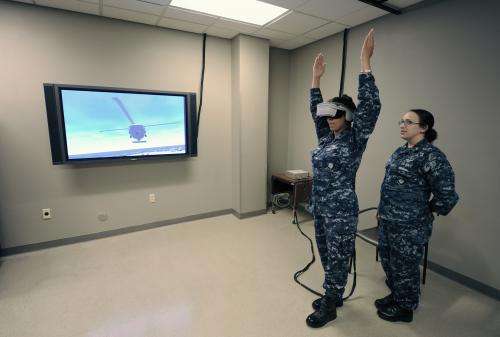NORFOLK (Sept. 19, 2013) Aviation Boatswain Mate (Handling) 2nd Class Ashley Tate and Aviation Boatswain Mate (Handling) 2nd Class Heather Landry, instructors with Helicopter Sea Combat Squadron (HSC) 2, demonstrate the Office of Naval Research (ONR) TechSolutions Landing Signal Enlisted trainer. The ONR TechSolutions program accepts recommendations and suggestions from Navy and Marine Corps personnel on ways to improve mission effectiveness through the application of technology. Credit: U.S. Navy photo by John F. Williams/Released
Answering the fleet's call for more authentic training environments, the Office of Naval Research (ONR) is delivering a more cost-effective, realistic simulator to train Sailors responsible for directing the movement of helicopters aboard ships.
The Helicopter Control Officer Trainer (HCOT) is being used by HCOs and Landing Signalman Enlisted (LSE) personnel at naval bases in San Diego and Norfolk, where courses required by the chief of naval operations are taught.
The trainer initially was developed after Chief of Naval Research Rear Adm. Matthew Klunder visited Naval Air Station North Island, San Diego, Calif., and talked to Sailors about ways to make their virtual training more realistic, taking into account moving ships, crashing waves and blinding rain, among other variables.
"These dedicated Sailors play an important role in shipboard aviation, and they wanted a training environment that was as lifelike as the challenges they face in the shipboard environment," Klunder said. "Staying in constant contact with the fleet allows us to quickly and effectively address concerns from the flight deck up to the bridge without breaking the bank."
Upgrades to the HCOT simulation eliminate the need for costly maintenance of aging hardware by combining training for personnel both HCOs in a ship's flight control tower and LSEs on the ship's deck coordinating take-offs and landings with hand signals.
For those manning the control tower, the setup features five touch-screen monitors with the same controls they would use at their shipboard stations. Instructors inside and outside of the mock tower play the roles of helicopter pilots or other crewmembers who would interact with the officers.
For the signalmen, a piece of headgear gives them a 360-degree view of a virtual ship deck. Another individual then uses a video game controller to either launch or land a helicopter based on the student's hand signals.
The system can throw anything at the students, including rainstorms, nightfall, crashes and fires, offering a level of realism unavailable with previous systems.
"It's like the difference between night and day," said Aviation Boatswain Mate (Handling) 2nd Class Joshua Chorniak, an instructor with Helicopter Sea Combat Squadron Two at Naval Station Norfolk, Va. "Before, we had to tell students to pretend. Now, we can say that this is exactly what you're going to see when you get out there."
The upgrades were spearheaded by ONR's rapid-response TechSolutions program in conjunction with Naval Air Warfare Center Training Systems Division (NAWCTSD) Orlando and Lockheed Martin. Designed to bridge the gap between warfighters and scientists, TechSolutions accepts requests directly from Sailors and Marines and delivers prototypes to them within 18 months.
Provided by Office of Naval Research






















